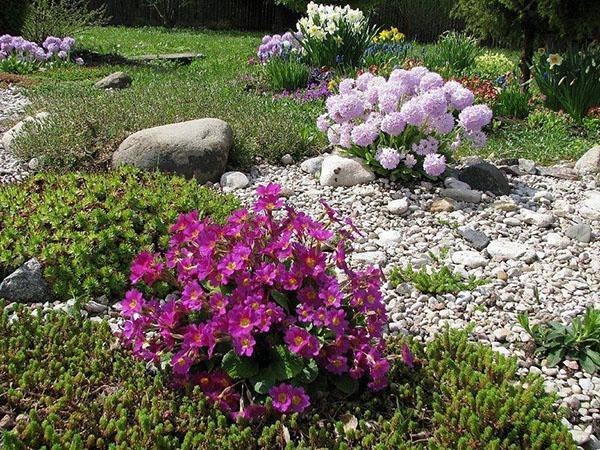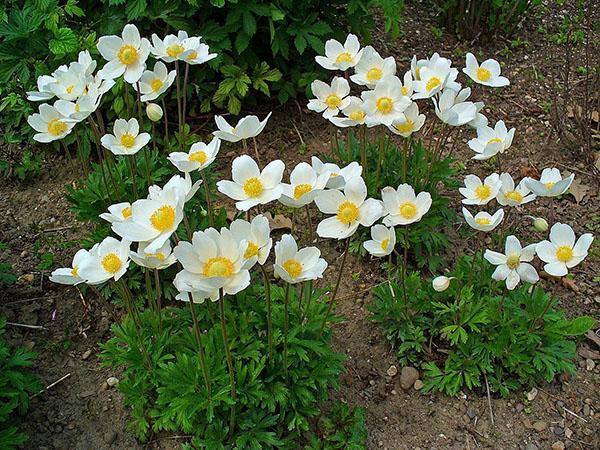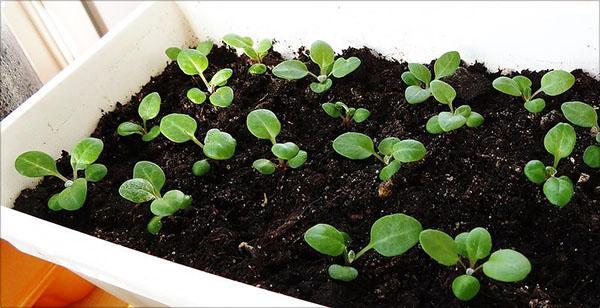Graceful multi-colored anemones - planting and competent care
 How pleasant it is to observe thousands of beautiful flowering plants around you, filling the earth. Among them, it stands out for its bright color - anemone. It is a delicate perennial garden flower. Its name comes from the Greek word "anemos", which means wind. The people call the flower anemone because of its delicate petals that react even to a weak breath of wind.
How pleasant it is to observe thousands of beautiful flowering plants around you, filling the earth. Among them, it stands out for its bright color - anemone. It is a delicate perennial garden flower. Its name comes from the Greek word "anemos", which means wind. The people call the flower anemone because of its delicate petals that react even to a weak breath of wind.
Anemone is a perennial plant with inflorescences of various shapes and colors. It looks wonderful in the company of other garden plants and against the background of decorative stones. To please yourself with these flowers, it is advisable to get to know them better. Read: Monarda - planting and care in the open field with a photo.
Easy ways to plant anemones

In accordance with the careful observations of color lovers, the rhizome planting of anemones and caring for it does not require special attention. In addition, such flowers tolerate winter comfortably.
Before planting an elegant garden beauty, you should choose the right place. To protect the delicate petals from the summer heat, it's best to find a slightly shaded area. Here the anemone will receive enough light and warmth for full growth.
If she finds herself in an area unprotected from the sun, the petals lose color and fall to the ground. In a dark place, flowers bloom later and are much smaller.
Since there are many different types of anemone, lighting, watering, and soil composition requirements vary widely. But such universal conditions are suitable for any kind:
- slightly shaded garden area;
- reliable high-quality drainage;
- loose fertile land.
It is these principles that will help beginner flower lovers grow unfamiliar plant varieties.
A small amount of sand can be added to create a suitable soil. This will loosen it up and provide excellent air circulation. In addition, such a soil does not retain moisture, which contributes to the prosperity of the plant.
When the planting site is ready, you should choose a method for growing and caring for the anemones outdoors. The simplest is sowing seeds. This method is used extremely rarely, since it is not always effective. According to the observations of gardeners, only a small part of the seeds sown germinates. And even then, if they are fresh. However, such a method exists.
Seeds are sown in shallow holes. This will help the delicate stems rise above the ground and harden. In this case, the soil should be porous and loose.
If you sow anemone in the fall, then the seedlings will appear at the beginning of spring. For spring or summer planting, the sprouts hatch within a month. During this period, you should water them wisely so as not to overdo it. The plant may die from waterlogging.
Care and planting of anemones in the open field in a vegetative way is widely used by experienced gardeners. For this, rhizomes or tubers are taken. Then they are neatly divided into pieces. In each, 2 or 3 kidneys must be left. Subsequently, they will become the crown of an elegant garden flower.
 When the question arises about when to plant anemones, in the fall or spring, the breeding method should be considered.Just the option of dividing the rhizome is best done in the spring. During this period, the plant is full of strength and easily reacts to such a radical procedure.
When the question arises about when to plant anemones, in the fall or spring, the breeding method should be considered.Just the option of dividing the rhizome is best done in the spring. During this period, the plant is full of strength and easily reacts to such a radical procedure.
It is much more difficult to grow these plants using tubers. To do this, before planting, they are filled with warm water. Being in a liquid, the planting material increases in volume. This has a beneficial effect on the germination rate of anemone in the open field.
 Another option for preparing the tubers is to wrap them in cloth or plastic for several hours. Then you can proceed to disembark. It is also important to consider the rules of how to plant anemones in the fall.
Another option for preparing the tubers is to wrap them in cloth or plastic for several hours. Then you can proceed to disembark. It is also important to consider the rules of how to plant anemones in the fall.
The upper part of the tuber is always flat, so it should be placed in the hole with the sharp tip down. A mixture of humus with wood ash is laid at the bottom of the hole, which serves as a starting top dressing. Then the planting tubers are spread at a distance of 10 cm from each other. Sprinkle with earth on top, slightly pressing down.
Sprinkle with clean water. Planting anemones in the fall in the ground is carried out at a depth of 3 to 7 cm.
To prevent the tubers from turning over in the hole, they must be fixed. One option is mulching.
Competent care of a garden beauty
Who doesn't like a garden decorated with more than 20 species of colorful anemones. Although there are much more of them in nature - about 170 species, garden hybrids require careful care.
 Almost all anemones are perennial plants... But they have different resistance to cold. Given this fact, it is worth considering whether it is necessary to dig up anemones for the winter so that they do not die.
Almost all anemones are perennial plants... But they have different resistance to cold. Given this fact, it is worth considering whether it is necessary to dig up anemones for the winter so that they do not die.
Most often, the plant's vitality is stored in thick rhizomes and delicate tubers. They are the planting material for flowers in early spring or autumn.
Depending on the weather conditions of the area in which the anemone grows, the time for extracting them from the soil is different. Usually, the appropriate months are September or October. Therefore, the gardener decides for himself when to dig up and how to store anemones in winter.
After removing the tubers from the soil, they are dried in a shaded area of the garden. Then the above-ground stems are cut and transferred to a cool room. There they dry for a whole month. For the winter they are hidden in the cellar, where they are wonderfully preserved.
The exact timing of when to plant anemones depends on the climate and the properties of the plant itself. In the southern part of Russia, plants are planted in open ground from April to early autumn. In cooler areas, consider the weather and air temperature to avoid freezing the plant.
In order for the anemone to take root after disembarkation, it is necessary to provide it with competent care. It includes such important points:
- Gentle hand weeding of young shoots.
- Regular loosening of the topsoil.
- Additional protection against cold winds and frost.
- Moderate watering of the plant.
In addition, young flowers need feeding. It is best to do this during the flowering period. If the land is fertile, once is enough.
Rhizome anemone can be mulched with peat and humus. The minimum layer is 5 cm.
Tuberous variants and hybrid varieties are fertilized with minerals and trace elements. This approach lengthens the flowering period.
 Proper care and planting of anemones in the Moscow region gives excellent results. Rhizome species thrive in this region and should be thinned regularly. This gives them access to light and air.
Proper care and planting of anemones in the Moscow region gives excellent results. Rhizome species thrive in this region and should be thinned regularly. This gives them access to light and air.
Some tuberous varieties are dug up for the winter. Those that remain in the ground, it is advisable to carefully insulate the fallen leaves.
 Sometimes gardeners use materials at hand for shelter: coniferous spruce branches or nonwoven materials. Perennial plants should be rejuvenated after 3 or 5 years.
Sometimes gardeners use materials at hand for shelter: coniferous spruce branches or nonwoven materials. Perennial plants should be rejuvenated after 3 or 5 years.
Adorable species of anemones
Anemone is a member of the buttercup family. Biologists classify over 150 species. Having considered just a few of them, you can immediately fall in love with this charming garden beauty.
 Anemone tender grows in the mountainous regions of Europe and Asia Minor. She loves moist fertile soils. It is a tuberous plant. Blooms in May for about 3 weeks with blue or purple buds. Grows up to 20 cm in height. There are also white, blue and pink types of delicate beauty.
Anemone tender grows in the mountainous regions of Europe and Asia Minor. She loves moist fertile soils. It is a tuberous plant. Blooms in May for about 3 weeks with blue or purple buds. Grows up to 20 cm in height. There are also white, blue and pink types of delicate beauty.
 Buttercup anemone has a creeping rhizome. It grows rapidly, completely covering the ground. Plant height up to 25 cm. It blooms in nature with bright yellow inflorescences in mid-May. Cultivated varieties come with purple leaves and double petals.
Buttercup anemone has a creeping rhizome. It grows rapidly, completely covering the ground. Plant height up to 25 cm. It blooms in nature with bright yellow inflorescences in mid-May. Cultivated varieties come with purple leaves and double petals.
 The oak anemone grows in almost all forests of Europe. It blooms with white inflorescences up to 4 centimeters in diameter. Sometimes there are pink, lilac or cream shades of petals. In its decorative form, there are more than 30 species.
The oak anemone grows in almost all forests of Europe. It blooms with white inflorescences up to 4 centimeters in diameter. Sometimes there are pink, lilac or cream shades of petals. In its decorative form, there are more than 30 species.
Due to their attractiveness, these flowers are used for group plantings. They look cute at the foot of shrubs or near garden paths.
Any variety of this graceful beauty will bring joy to real flower lovers.